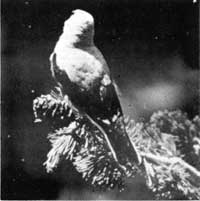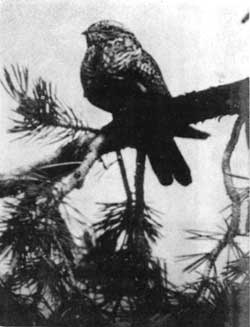I Was Robbed!
Unable as I am to understand the Clark nutcracker’s grating vocal repertory, this story is subject to certain inaccuracy.
 Nutcracker on white-bark pine From Kodachrome by Welles & Welles |
You see, a Clark nutcracker of unquestioned sobriety was struggling with a white-bark pine cone located at the tip of a particularly flexible limb. On one occasion, this large grizzled bird was thrown almost upside-down as he was grasping the tough cone with both feet and prying with his crowbar-like bill in an effort to dislodge the seeds of this unwieldy cone.
Whoops! — then it happened. The cone fell loose from the branch. The Clark nutcracker struggled for an instant in regaining his composure before gliding down after the escaped cone.
At this point, the “villain,” who had watched the procedure with apparent detachment, entered the stage. Nutcracker number two was first to reach the now more stable cone and continued with the job of gouging seeds from under the scales.
The first bird, with savoir faire, withdrew to a lower and sturdier branch, fluffed its feathers, and gazed into space with an appearance of complete unconcern.
High Places
To most of us there come times when we need to seek a quiet refuge, a place where we may be alone. Each has his own idea as to where to find this sanctuary.
A church or cathedral answers the need for some. A sandy stretch of shore with the sound of breaking surf, or a path in the woods along a moonlit stream, brings peace and calmness to others.
I seek and find in the high places the feeling of oneness with the source of all. Alone on a mountaintop one gains perspective. “Lift up shine eyes unto the hills.”
Lost Creek Ramblings
CHAPTER ONE
By J. Francis Stine
Termites to the right, termites to the left! This was our impression on the night of June 21,1954. We had just retired in our seasonal quarters at the Lost Creek Ranger Station when this gnawing action started. Upon investigation it was discovered to be produced by two porcupines enjoying a “feast” of cabin wood. These porcupine visitations were common occurrences during the first month of our stay. Porcupine dinner hours always began around midnight — we retired at 9:30 p.m. — and continued until we interrupted their meals (about 12:30 a.m.).
Did you ever try fumbling around in the dark for your shoes, lighting the lamp and preparing yourself for the brisk evening air, and upon going outside find Mr. Porcupine in comfort half-way under the cabin? Best do as we — return to your bed, pull the covers over your head and leave the porcupines to their last three or four courses.
It didn’t take long to make friends with the golden-mantled ground squirrels. We spent many early-morning hours feeding them various bits of food. We found their favorite early-morning course to be cantaloupe. On July 27, we first noticed the young ground squirrels. There were six youngsters in the first family that appeared. We frequently placed food for these ground squirrels on our woodpile.
One morning, July 6, we were startled by a loud chattering. Upon looking out the window, we observed a pair of gray squirrels, Sciurus griseus griseus Ord, crossing the yard toward the woodpile. They investigated the food, but it apparently didn’t appeal to them and they went chattering on their way. These gray squirrels were seen frequently until the 20th of July. Gray squirrels are rarely seen within the park boundaries. Previous reports have been for the immediate vicinity of the South Entrance Ranger Station; this encounter, therefore, provides a new locality record for the species inside the park.
A large black bear was a frequent visitor in our camping area. Marmots and conies were observed on hikes to the head of Lost Creek and along the banks of Sand Creek.
During the first part of July, we observed dozens of western tanagers picking up nesting materials. We tried very diligently to locate one of their nests but were unsuccessful. After July 26, we saw only a few in the area and after August 1, none. The rosy finch was also a frequent visitor, along with the nuthatch, chickadee, pine siskin, yellow warbler and red-shafted flicker.
On August 15, while on duty at the entrance station, I saw a fox. He first appeared about fifty feet away, making his way toward our quarters. After his second trip over and after an interval of about ten minutes, he reappeared about twenty-five feet from the station. He walked very slowly across the road and then stopped. He took one look at me, sauntered into the trees and then paused. Looking around a tree trunk, as though he could not believe his own eyes, he seemed to be thinking to himself, “Look what they are putting in cages now!”
 Contrary to the books, this nighthawk sat crosswidse on a limb Photo by Welles & Welles |
CHAPTER TWO
By Mrs. Marcella Stine
On the morning of July 18, my daughter and I were roaming the area about one-third mile southeast of our Lost Creek cabin, when we unexpectedly flushed a bird. After some searching, we discovered two eggs on the ground in front of us. With the help of Ranger Naturalist Robert Wood, we learned that the bird was a Pacific nighthawk.
We made daily trips to the nest as we wanted to be on hand for the hatching of the eggs. They hatched a day apart, on July 27 and 28. They were the darlingest little balls of down we had ever seen. We continued our daily trips to the nest, in order to keep track of them. On August 1, we found them eight feet from the nest. From that day on, we never found them in the same place twice. On the 7th, we noticed that they were full of pin feathers. On the 11th, they were completely feathered out and were very aggressive for such little fellows.
Despite many trips to the nesting area, we had never seen the male parent. We were beginning to think that the mother was a widow. We were very anxious to watch the feeding of the young birds. On the 6th of August, at 7:30 p.m., I heard an adult bird in the air and knew that feeding time was at hand. I rushed to the nesting area, darting from tree to tree as the adult bird glided through the air catching insects. I managed to get behind a large pine, just eight feet from the young birds. For several minutes I watched the adult feed the young, thinking all the while that it was making extraordinarily quick trips back and forth with food. Then, to my surprise, two birds came down with food at the same time. This was the first time that any of us had seen the male for certain.
I went home then, happy to know that the youngsters still had a father to help look after them.
(Through the efforts and cooperation of the Stine family for about a month, Ranger Ralph Welles and his wife “Buddy” Welles were able to take the picture story which follows. – – – Ed.)

